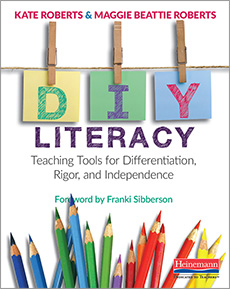Wow, I can't believe this is the last week for #CyberPD 2016 already. This week we will be discussing chapters 5 & 6. Next week is our final Twitter Chat with Kate and Maggie Roberts, the authors of the book we are studying, DIY Literacy.
Chapter 5
This chapter focuses on tailoring our teaching to meet the needs of every student. Differentiation, something every teacher hears constantly, but which is much harder to successfully accomplish within the classroom. It is difficult in this current climate of over testing and pressure on the teacher to make sure student's perform to really take time to meet every child's needs individually. There never seems to be enough time to determine the needs of 25+ students, find or create the materials for them, and then find time within a 40-60 min. block to help every student.
Yet Kate and Maggie have provided us with a short list of tools that can make a greater impact on a greater number of students. They provide us with a way to maximize our impact within our classroom. "Teaching tools won't make the work of differentiation effortless. But they make the work we put in have bigger payoffs, for us and for the kids." pg. 73
- Demonstration Notebooks: These provide us with a great way to help meet the varying needs of our students during individual conferences and small groups. The short demonstrations and lessons in this notebook are made to fit the specific needs we see within our classroom. More importantly, I love that it is pointed out in this chapter that these pages can be made to help those who have mastered the current content and are ready for a challenge. They are not just pages for those with gaps or those who are struggling with the current unit, but for every student at every level.
- Charts: I love that these are included and again in a way I would not immediately think of using them. To use a chart, not just to provide steps, but to provide a list of student struggles or levels and the strategy they can use to help move them past it. I can not wait to implement this. I feel it will have a drastic impact on the independence and success of my students.
- Bookmarks: What better way to meet each students' individual needs than to have them create a bookmark filled with strategies that work best for them during any particular unit! "Having students represent ideas and strategies in drawings, shapes, and icons helps them understand and hold onto the work." pg 81
- Micro-Progressions: I don't think I could explain it any better than Kate & Maggie. "Micro-progressions help differentiate the work of a unit because no matter where a child is on the micro-progression of that skill, they can find themselves within the range of levels and take their next step." pg. 83 This is the tool I am the most excited about using in the new school year. The independence that I foresee the micro-progression nurturing in the students is profound, and that is exciting!
Chapter 6
This chapter focuses on tips and tricks to make using these DIY teaching tools more accessible and easy to use within the realities of a busy classroom. Below I discuss my favorite tips from the chapter:
- Use popular culture references to get the attention of students. I particularly like the idea of having a regular anonymous survey of what the students are interested in at the moment. It lets them have direct control of what is included in the class. pg 89
- Hire "experts," students who show mastery of a skill, to create tools to help those students still on their way to mastering the skill. Empowering the students who are creating the tools to learn the skill more deeply and at the same time creating a more understandable tool for those students still working toward mastery. pg 93
- "Place your demonstration notebook on a table for students to check out for the class period, just like a library book." pg 95
- Keep white space in the design of the tools to help readers understand what they are reading. Write big and create separate sections. Add color, especially shades of color, and keep the color of sections or titles consistent. Color makes the tools interesting and engaging! pg 100-101
In Closing
The tools that Kate and Maggie provide in their book are tools that I have been told about or even used before, things that are often mentioned in the field of education. However, the advice that Kate and Maggie give about how to use these tools effectively in order to help the common problems of student memory of the lessons, rigor of student work, and differentiation within the classroom is new to me. They make these tools understandable and functional within a messy, chaotic, and busy classroom with 20+ students. I thoroughly enjoyed reading this book and am excited to finally get to use these tools in a consistent way that truly reaches the students and encourages independence in their work.







